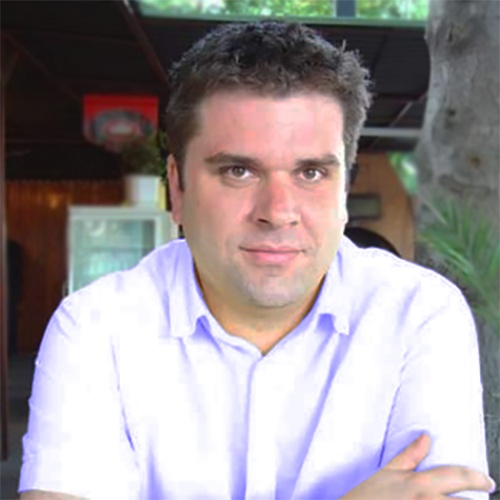
Steve Hughes
Senior Data Scientist
StayinFront RDI
Steve Hughes has been a Senior Data Scientist with StayinFront Retail Data Insight (RDI) for 4 years. During this time, Steve has been responsible for developing our advanced analytics function. He works to deliver cutting-edge solutions that transform data and deliver measurable sales growth to leading consumer goods companies globally. Steve has a particular interest in data analytics for markets where Point of Sale (POS) data is not available. He is also passionate about advanced analytics and AI techniques that interpret the available data sets.
Prior to joining StayinFront RDI, Steve was employed by several of the UK’s retail giants including Sainsbury, Boots, and Kingfisher, where he developed advanced analytical solutions to guide decision-making. He has also applied these skills in other industries such as Telecommunications, Fashion, Finance & Insurance Risk.
Steve now turns his focus to utilizing the power of Machine Learning and AI to drive sales growth and measuring RDI in global emerging markets. Growing sales through cost-effective means in developing markets is a known Digital Transformation strategy for many of today’s leading brands. Emerging markets require large amounts of external geographic and demographic data, as well as internal data sets to solve business challenges. Teams getting started in these markets may ask, ‘What stores should I call on?’ or ‘What is the optimum range for this location?’ and ‘What are the most effective actions to execute in this store?’ Together with StayinFront RDI, Steve provides the answers.
Based in Lincoln, UK, the StayinFront RDI team delivers services across five continents. Today, we sit down with Steve to discuss his career, the emerging markets he’s been able to improve with StayinFront solutions, and how harnessing AI and Machine Learning forged new paths to success.

Steve, you have held various senior Data Scientist roles in the Consumer Goods space; what key skills do you need for a successful career in Data Science?


If you asked that when I was starting my career – too long ago to remember – I would’ve cited the obvious: a solid academic background, programming experience, and skills in mathematics. Today, the whole field has changed. Now, the skill I look for first is an inquisitive mind.
Data Scientists who make the difference are the ones willing to explore everything. They work out if and how any circumstances or environmental factors play a part and how those things will integrate with their client’s existing data sets. Today’s world is overloaded with potential data sources and its availability grows exponentially each year. Arguably, it even grows more rapidly than Machine Learning and AI techniques do.
Another skill is the willingness to continually learn. We work in an area where there is volatility in the environments our clients are operating in. The increasing capability of our Machine Learning toolsets and the availability of new and novel data sources all converge and change at an incredible pace. Keeping your eyes open is critical. If we don’t do it, our competition will.
The final skill I’m looking for is the ability to commercialize the outputs. Return on Investment (ROI) is as important as ever. You can create the most amazing solution possible, but if you can’t translate how that is going to drive value, it’s a non-starter. Being able to simplify a complex concept and – most importantly – communicate the upside to clients is key. A long time ago, Data Scientists didn’t have to do that. This skill transforms data into knowledge and translates that into action. Transforming data into actionable, measurable insights is the objective. What is produced must be easily understood, acted upon, and constantly advanced.

How have these roles contributed to your role as Business Intelligence Manager at StayinFront RDI?


I think what’s really helped me is viewing how different organizations in the consumer goods space approach similar problems. It allows you to take a more rounded approach by cherry-picking the best bits of what you’ve seen. Then, you can add your own ideas, apply the right tools to leverage relevant data, and develop the highest quality solution.
Working in industries unrelated to CPG/FMCG has also been a great foundation. For example, at StayinFront RDI, I’ve applied techniques that I discovered when working in financial services. Industries tend to get attached to certain techniques and may be resistant to new ones. The key to staying ahead is always asking, “what new ideas can be brought forward?”
We also have an excellent team of experienced CG industry analytics professionals that contribute to each project. One of the things I really enjoy about working here is the community of like-minded people. They help to support the development of my ideas and still allow me space to explore on my own. When something doesn’t work – we forget it and move on. If it does – great! Let’s work together to get it built as a product and deliver it as a service.

I understand one of your areas of deep expertise and current focus is working with markets or channels that do not have access to Point of Sales (POS) data; can you explain how this works?


The biggest challenges in implementation and operations support revolve around understanding user expectations and delivering what is truly essential. I find that in most systems deployed, the 80/20 rule holds true: People tend to want a lot of functionality when in fact they only use 20% of the core functionality in any system. It’s important to maintain a holistic approach but also understand the real core needs. Often times, this requires in-depth investigation and fact-finding.

You’ve spent some time selling technology solutions in the UK, has anything in that experience helped you with your role today?


Yes, we are. Although the model will change from market to market depending on what data we have. Before we begin any pilot, we carefully work with the client to determine the goals, decide on the best design, and ensure we can analyze the benefits.
Typically, we would see volumes increase between 3% and 9% for the non-POS market. That liberates hidden demand by matching the right stores to the right products. The end consumers now have the products they want on the shelf. They buy more, the store orders more product, and a new cycle of progress emerges.
Surprisingly, the uplifts we see in non-POS markets tend to exceed those in POS markets. This is because prior to deploying our solutions, nobody else has been able to solve the problems these markets typically face. In POS markets, there’s a wealth of data to base your range on, so it’s hard to fall far behind the curve. There’s also only so much influence you can make on a call. Creating organic opportunities in established POS markets just doesn’t gain the same momentum.
The locations I specialize in are all independent. We follow a simple routine: turn up, highlight the better brands, and get them sold to the store. The Size of Prize (SOP) potential is simply much larger; both at the percent uplift level and the overall size or mass of the market. It often adds up to a lot of extra cases of product moving out of the distribution centers.

AI and Machine Learning are increasingly important in driving effective retail optimization. How does StayinFront RDI’s solutions incorporate AI technology?


We leverage Machine Learning and AI in all StayinFront RDI offerings. Two examples are Predictive Range Optimization and Predictive Call File. These products appear at first to just solve the problems, but we are using tools and computing power to ensure we deliver extremely accurate solutions that also drive ROI. I’ve already discussed range optimization, but we apply similar techniques to entire stores. We recommend these techniques get placed on the call file at the expense of an alternate store.
Ideally, one would be working with a ‘store list’ and sometimes the client has this already. It can also be purchased or sometimes even physically surveyed. If all else fails, AI steps in to create the list. We can point people to very tightly defined geographic areas where we expect lots of valuable stores to be found. Think 100 meters by 100 meters! There’s always a solution – even when the data dries up.
Another example is our Digital Merchandising offering which is based on advanced Image Recognition. There are so many benefits to this. In terms of timesaving, it’s a game changer. Instead of auditing products on a shelf using survey style inputs, now it’s a matter of pointing your camera, pressing a button, and it’s done. This can be transformed and blended with our POS alerts. For example, when a client is faced with missing or under-faced SKUs, we can attach an expected opportunity lost KPI. This means the field rep can be instantly alerted when anything is not in alignment with the planogram. These solutions are all a part of our innovative Retail Optimization Platform (ROP). ROP brings together data, apps, and services to help our clients drive growth. Finally, our ROI View services allow clients to prioritize in-store actions to ensure the highest value opportunities are seized.

On the topic of AI, the StayinFront Retail Optimization Platform (ROP) is a leading driver of Digital Transformation for consumer goods companies. How do StayinFront RDI solutions fit into the StayinFront Retail Optimization Platform?


StayinFront RDI solutions incorporate cutting-edge AI and Machine Learning to help our clients grow their businesses. RDI solutions are fully integrated into the StayinFront Retail Optimization Platform (ROP). Think of it like a body. The ROP is the centralized ‘brain’ that sends signals to the powerful ‘arms’ and ‘legs’ of the individual applications. This all comes together to unlock new selling opportunities. Uniquely, StayinFront RDI solutions can identify the Size of Prize (SOP) associated with fixing retail execution issues. Along with the alerts received in Touch CG, it can track the incremental sales impact from the field team’s interventions. The measurement of sales impact closes the loop for CPG clients. This enables them to record the positive impact of their Digital Transformation journey and justify future investments to drive perfect store improvements.

Looking ahead, what do you see as some of the key technology disruptors at StayinFront RDI?


I think there are many AI point solutions in the market. We, however, are unique in offering integrated solutions within our Retail Optimization Platform (ROP) that leverage and transform data. Image Recognition and crowd sourced data are essential to delivering cost-effective, measurable Digital Transformation to our clients. We’re very focused on building and utilizing the capabilities and data captured by ROP.
Let’s imagine you are a field associate starting your day by logging on to StayinFront ROP. One of the solutions has identified live problems with various products in various stores. Dynamic Route creates an optimal journey plan to drive growth. This plan would be based on all known problems; it could even account for environmental factors like local traffic. On store visits, you photograph shelves. The ROP application uses the data you have just gathered in the photos you’ve taken to create a list of Next Best Actions. Moving on, there are some new products you’d like to recommend. There is plenty of time in your schedule to have a conversation with the store manager. On the way home, StayinFront ROP identifies a potentially valuable new store and alerts you that you’re nearby. You swing by, answer some questions, and perhaps it’s on your next call file. Sounds like a productive day, right?
It’s quantifying and prioritizing actions based on data that determine the real improvement. As the name implies, Machine Learning learns. The more it learns, the more data you can share with it. By integrating what we know about things like products, stores, consumers, catchment areas, or shelf conditions; the AI models can deliver ongoing measurable process improvements.
Our goals are not only to deliver a singular solution, but to constantly evolve our technologies to deliver consistent sales growth in every market, for every client.
Thank you Steve for taking the time to share your thoughts with us today.
As the CEO of StayinFront, Tom Buckley is the driving force behind the company’s vision and growth and has built a team of top-flight managers and strategic alliances with key industry partners. With a vision of leveraging technology to solve business problems, Tom founded StayinFront in 2000. He has grown the company into a leading global provider of SaaS-based mobile field solutions in the life sciences and consumer goods industries with successful deployments in over 50 countries across six continents.


Thomas Buckley
Chief Executive Officer
StayinFront
RECENT INTERVIEWS


Subscribe To News & Updates
Quick Contact








